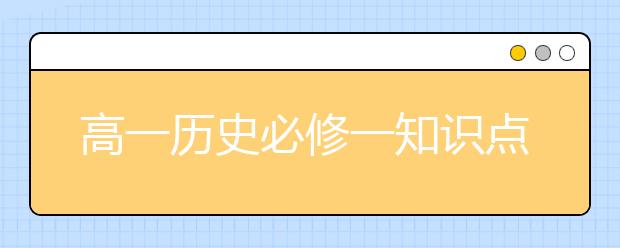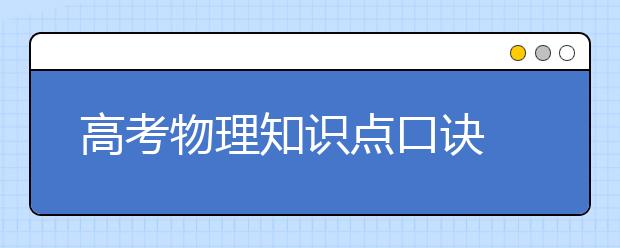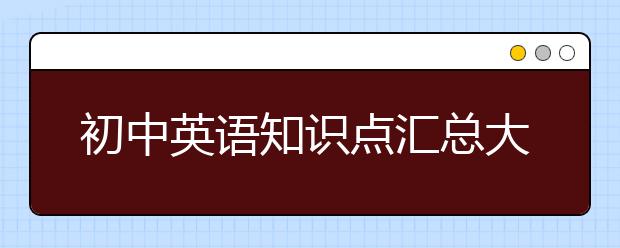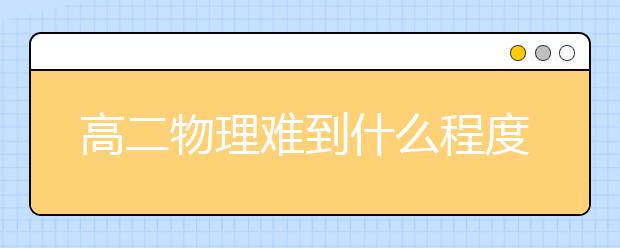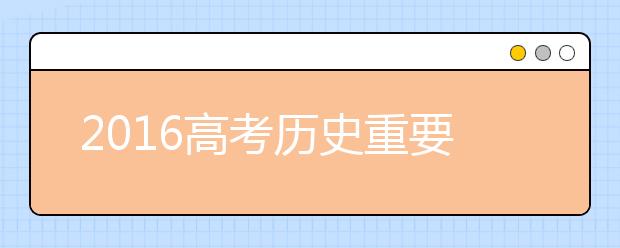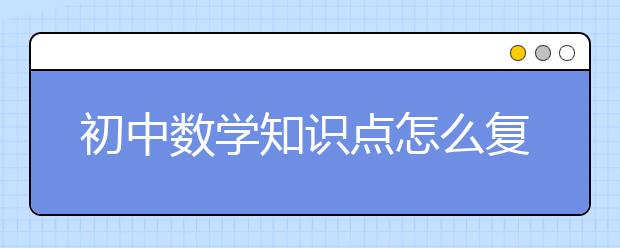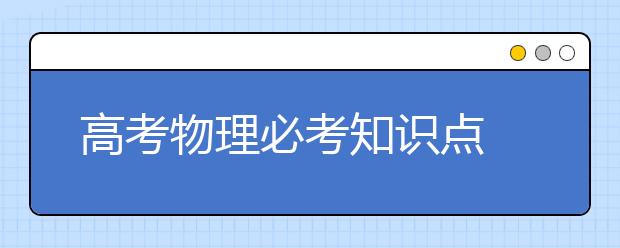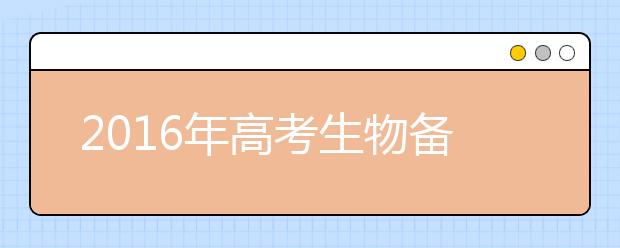初中的英语水平决定着你以后你的英语水平会发展到哪一个阶段,在初中阶段,很多学生都会出现一些偏科,当然有很多同学呢,他的英语就特别差,以至于会影响到自己的整体成绩,今天金博宝188官网小编就来和大家分享下初中英语知识点总结归纳。
1.冠词 a / an 的用法
a用于辅音音素前 a useful book, a university, a “u”
Once a week have a swim/walk/talk/look/dance/drink/ rest have a cold/ headache / fever /cough have a good time have a try in a hurry after a while keep a diary go for a walk in a minute in a word in a short while
an则用于元音音素前 an hour, an honest boy , an “A E F H I L M N O R S X”
keep an eye on
定冠词the的用法:
1)特指双方都明白的人或物: Give me the book.
2)上文提到过的人或事: ---Do you know the lady in blue? –Yes, she is a teacher of a university.
3)指世上独一物二的事物the sun ( sky / moon/ earth/ world/ nature/ universe )
4)单数名词连用表示一类事物,如:the dollar 美元; The lion is a wild animal.或与形容词或分词连用,表示一类人:the rich /poor/ blind/ aged / living / impossible
5)用在序数词和形容词最高级,及形容词only,very, same等前面:I live on the second floor.
6)用在表示身体部位的名词前: She caught me by the arm.
7)用在表示乐器和表方位的名词之前: She plays the piano violin guitar in the north of China
8)用在普通名词构成专有名词前: the People's Republic of China the United States the Great Wall the Summer Palace
9) 用在姓氏的复数名词之前,表示一家人:the Greens are playing the piano.
10) in the day, in the morning (afternoon,evening), in the middle (of), in the end, all the time at the same time on the whole, by the way, go to the cinema at he age of six at the beginning of the twenty-first century on the other side of at the moment the day after tomorrow the day before yesterday, the next morning, in the sky (water,field,country) in the dark, in the rain,
2.不用定冠词的情况
1) 国名,人名前通常不用定冠词:China , Europe 欧洲 Lei Feng 雷锋
2)物质名词和抽象名词表示一般概念时,通常不加冠词;当表示特定的意思时,需要加定冠词Failure is the mother of success. 失败乃成功之母。
3)在季节、月份、节日、 假日、日期、星期等表示时间的名词之前,不加冠词; Children’s Day Mother’s Day Father’s Day
4)在称呼或表示官衔,职位的名词前不加冠词; He is captain of the team.
5)在三餐、四季,球类运动、学科、娱乐运动的名称前,不加冠词 如:have breakfast /supper / lunch,play basketball / football / volleyball / chess , in spring/summer/ autumn/ winter
6)当by 与火车等交通工具连用,表示一种方式时,中间无冠词;by bus/ train/ taxi/ bus/ ship
7)Day and night face to face side by side step by step watch TV at school / work / home at first/ last in danger in trouble on foot on duty on watch in bed on time in time go to school go to work by taxi / bike at noon at night on TV at town
3.部分词组有无冠词的区别
in hospital 生病住院 in the hospital 在医院里
in front of 在---的前面in the front of 在----内部的前面
go to school 上学go to the school 到学校去
a number of = a lot of 许多,谓语动词用复数。
The number of ----的数目,----的总数, 谓语动词用单数(第三人称单数)
名词:专有名词和普通名词(个体名词、集体名词、物质名词、抽象名词)
可数名词的单数变复数①一般情况加s ②以s, x sh ch,等结尾的词加-es bus-buses watch-watches ③以o 结尾的名词,无生命的加s,如: photo---photos piano---pianos 有生命的es,如:potato--potatoes tomato--tomatoes 均可,如:zero---zeros / zeroes ④以f或fe 结尾的名词,去f, fe 加ves,如:half---halves knife---knives leaf---leaves wolf---wolves wife---wives life---lives thief---thieves (加s,如:belief---beliefs roof---roofs safe---safes gulf---gulfs;)⑤以辅音字母+y结尾的词,变y 为i,再加es baby---babies ⑥不规则:a. 单复数形式一样。Sheep, deer, Chinese, Japanese. People, police, scissors, trousers b. 其他的。foot—feet tooth---teeth child—children mouse---mice man---men woman---women businessman ---businessmen
German---Germans women doctors
集体名词: People, police,(一般表示一个整体,谓用复数) class, family, glasses
不可数名词:
常见的不可数名词有:information, news, room (空间), work, work, weather, advice, bread , food, milk, tea, ice, glasses, meat
①A little, a bit of, some, much, a lot of, quite a lot of 常修饰不可数名词.
②不可数名词作主语,谓语动词用单数。
③如果用and连接两个不可数名词作主语时,谓语动词用复数。Time and money are-
④A cupglassottleoxkilogroup crowdclasspair of
Two and a half kilos of = two kilos and a half of
名词所有格 在英语中有些名词可以加"'s"来表示所有关系,带这种词尾的名词形式称为该名词的所有格,如:a teacher's book。名词所有格的规则如下:
1) 单数名词词尾加"'s",复数名词词尾没有s,也要加" 's ",如the boy's bag,men's room Children’s Day Mother’s Day Father’s Day
2) 若名词已有复数词尾-s ,只加" '",如:Teachers’ Day ladies’ room twenty minutes’ walk
3) 凡不能加"'s"的名词,都可以用"名词+of +名词"的结构来表示所有关系,如:the title of the song 歌的名字; A picture of family; a map of China
4) 在表示店铺或教堂的名字或某人的家时,名词所有格的后面常常不出现它所修饰的名词,如:the barber's 理发店。
5) 如果两个名词并列,并且分别有's,则表示"分别有";只有一个's,则表示'共有'。 John's and Mary's room(两间) John and Mary's room(一间)
6) 复合名词或短语,'s 加在最后一个词的词尾。 如:a month or two's absence
7)双重所有格 a friend of mine / hers / his / theirs a friend of Mary’s mother’s
代词
1、人称代词、物主代词和反身代词
I—me—my—mine—myself you —you—your—yourself (yourselves)
he—him—his—his—himself she—her—her—hers—herself
it—it—its—its—itself we—us—our—ours—ourselves
they—them—their—theirs—themselves
人称顺序you, he, she, I ; we, you, they
主格作主语;宾格作宾语,动词和介词之后通常作宾格;形容词性物主代词不能单独使用,通常放在名词之前;名词性物主代词=形容词性物主代词+名词,“of+名词性物主代词”表示所属关系。A friend of mine我的一位朋友; teacher of hers 她的老师
代词it 的用法:
①指代前面提到过的事物②表天气。③表距离。
④指婴儿和不明身份的人。 ---John, someone in your class phoned you this morning. ---Oh, who was it?
⑤用作形式主语。
It’s kind / good / nice /clever /polite / foolish of sb. to do sth.
It’s important / necessary / possible / easy / difficult for sb to do sth,
It’s time to get up.
It’s time for lunch.
It’s one’s turn to do
It seems that
It takes sb. some time to do sth.
⑥用作形式宾语。Find / think / feel + it +adj +to do sth
It one 的区别
It 特指上文提到的同一对象,同一事物。
one同类而不同一。
that常用于比较结构中,代替前面提到的名词,以避免重复。
反身代词
构成规则:一、二物主,三为宾。
运用:hurt/ teach/ wash / buy/ enjoy oneself
by / Help oneself (one selves) to --- / Look after oneself / Say to oneself / Come to oneself
2、不定代词 little, a little, few, a few=several(some), some, any much, too much, much too, more then =over, less than= nearly
something 某事,某物,用于肯定句。注意:⑴由复合不定代词作主语时,谓语动词用第三人称单数。Everyone is here.
⑵修饰不定代词的形容词后置。I have something important to tell you.
⑶在反意疑问句中,表示人的复合代词在陈述句中作主语时,附加问句中的主语用he或they,表物的用it 。
anything 任何事物,某事物,用于否定句、疑问句。
everything 每件事,一切事物,用于各种句型。
nothing没什么,没有任何东西。=not ----any thing
somebody 某人,有人=someone
anybody 任何人(用于否定句、疑问句,条件从句中)
nobody没有人
little, 几乎没有,表示否定意思,用以修饰不可数名词。
A little ①一点点,表示肯定,用以修饰不可数名词。Only a little 仅一点点.②也可修饰形容词和副词。③一点点,放在动词、动词宾语后。
few几乎没有,表示否定意思,用以修饰可数名词。
a few=several 几个, 一些,表示肯定意思,用以修饰可数名词。
some 一些,修饰可数名词,后跟复数形式名词或ones, 也可修饰不可数名词。在表示请求、委婉语气的疑问句和表示希望得到对方的肯定回答的问句中,常用some. Could you give me some apples?
any 一些,任何一些。 一般用于疑问句中或否定句中和IF 引导的条件句中。
much 许多。修饰不可数名词,放在不可数名词前,可用a lot of 替换。
too much 太多的,用法相当于much ,放在不可数名词前。Heath is very important to us. We should eat more vegetables and fruit instead of too much rich food.
much too 太,用法相当于too, 放在形容词和副词前。Keep quiet! It’s much too noisy here.
more than 超过,多于。=over
more or less 或多或少,差不多。=about
at least 至少
a lot 许多,修饰动词。Thanks a lot.
a lot of = lots of 许多的,可修饰可数名词和不可数名词。
a number of 许多的,= many 只用于修饰复数形式名词,放在可数名词复数前。
every 用于三个或三个以上,着眼于整体。后可跟数词。词组有every ten minuets
each 用于两个或两个以上,着眼于个体。词组有each of
either 两个中任何一个
either ----or
both 两个都
both ---- and ---
both of ---
neither 两个中一个也没有 e.g. ---Do you like talking with your friends on the telephone or mobile phone? ---Neither, I enjoy using QQ.
neither --- nor ---
any 三个以上中任何一个
all三个以上中全部
none 三个以上中一个也没有。 None of ---中没有一个,表示三个或以上数目的人或物中没有一个,表否定,作主语时,谓语动词一般用单数。
others 表示“泛指”除自己外,别的人。Some ----, others -----
the other 表示两个中的另一个。One ----, the other ----
the others 表示特指的另一些。
another 后跟单数名词。表示泛指另一个人。后跟带数词的复数名词,表示“再,还要”的意思。
other 别的,另外的,一般后跟复数名词或ones , 在other 前可加some, many 或数词,表示“几个,一些别的”
Such a tall building such an exciting football match
so many people
each other相互,彼此,指两个或两个物时 。one another 相互,彼此,指三者或三者以上的彼此。one another’s 相互的,彼此的。
数词
表示数目多少或顺序多少的词叫数词,数词分为基数词和序数词。表示数目多少的数词叫基数词;表示顺序的数词叫序数词。
一、基数词和序数词
1)基数词写法和读法: ①百位与十位,用 and, 十位与个位,写时用“—”②先确定分节号,从右至左,每隔三位数是一个分节号。③第一个分节号是千位 thousand 4第二个分节号是千位 million ⑤第三个分号节是十亿位 billion. 1, 234 ,567, 892 one billion two hundred and thirty-four million five hundred and sixty-seven thousand eight hundred and ninety-two
2)分数表示法 构成:分子基,分母序,分子大于1时,分母在序数词后加S: 1/2 a half 1/3 one-third; 2/3 two thirds 3/4 three quarters = three fourths 2- 3/4 two and three fourths
3)表示"年代",用 in +the +数词复数; in the 1980s (20世纪80年代)
4)表某人几岁时: in +物主代词+数词的复数形式 in one’s twenties
5)He lives in Rom 88. One plus two is three. Three times five is fifteen.
6)hundred , thousand , million 等词前有具体的数字时,不能加S 如 three hundreds 这种说法是错误的
7)hundreds of thousands of millions of
8)a 21-year-old girl three days and a half = three and a half days one and a half hours = one hour and a half we’ll have two weeks’ holiday (two-week holiday)
9)(基数词变序数词的口诀)
一、二、 三特别记,th从四以上记;怎么加很容易,八减t,九减e; f来把ve替,见y变ie; 若是遇到几十几,变换个位就可以。
One-first two-second three- third five- fifth eight-eighth nine- ninth twelve – twelfth thirteen- thirteenth fifteen- fifteenth eighteen- eighteenth twenty- twentieth twenty-one---twenty-first thirty-thirtieth forty-fortieth fifty –fiftieth sixty- sixtieth seventy- seventieth eighty-eightieth ninety-ninetieth
序数词的缩写形式: first---1st second---2nd thirty-first---31st
形容和副词
①修饰something, anything, everything, anybody等不定代词的形容词,形容词要放在不定代词之后。I have Something important to tell you.
②enough修饰形容词、副词时,enough要放在形容词和副词之后。Far enough
③interesting, exciting, boring, amazing, surprising, moving 主语为物。Interested, excited, amazed, surprised, frightened, tired, pleased 主语为人。
④Much, far, a lot, a little, even等后要用形容词或副词的比较级。 I fell even worse now.
5.连系动词be, 感官动词(look, smell, taste, sound, feel )三个变(get, become, turn,) keep 后跟形容词.
⑥既可作形容词又可作副词的词有:
hard 作形容词=difficult , 作副词,放在work, rain等后,表努力地做。
well作形容词身体好; 作副词,做得好。
long作形容词,表事物的长度,作副词,放在last, talk等后,表动作持续。
Fast 作作形容,放在系动词后,作副词放在rain, make sth.等词后,表“做得快”。
High作形容词“山,海浪的高。作副词, 放在fly, jump 等后表飞得高,跳得高。
⑦五、形容词变为副词 ①+ly useful, wide, strong ②改y为i,再加ly healthy , heavy, happy, lucky, noisy, ③good ——well terrible---terribly probable---probably
⑧多数以ly 结尾的词是副词。 但friendly, lonely, lovely, likely, daily, lively 是形容词。
⑨China is larger than any other county in Asia. (同一范围内) China is larger than any county in Afirca. (不同范围内)
⑩how many 对可数名词数量的提问。How many people are there in your family?
How much 对不可数名词数量的提问和提问价格。
How long 多久,多长时间。回答常用:for + 段时间 since +点时间。
How soon 多快,多久以后。回答常用:in +段时间
How often 多长时间一次,提问频率。回答常用:once (twice) a week, three times a day, often
How far 多远,对距离提问。回答常用:fifteen minutes’ walk , 10 meters away
形容词和副词的比较级和最高级:
原级: as +原级 + as ; not as / so +原级 + as =反义词+than English is as interesting as Chinese. Mr. Zhang isn’t as old as Mr. Li. = Mr. Zhang is younger than Mr. Li.
比较级的标志词 ①than, Lily’s bag is bigger than hers.
②much, far, a little, even , next time
③which / who ---- A, B ? Which is more beautiful, Tom, Jim?
④the +比较级----,the+比较级---- The more we get together, the happier we’ll be.
⑤比较级+and+比较级 (多音节词和部分双音节词用more and more +原级) 越来越---- harder and harder , our hometown is becoming more and more beautiful.
最高级标志词:①the + 最高级 + of / in Shanghai is the biggest city in China.
②One of the + 最高级 + 名词复数 Zhou Jiekun is one of the most popular singers.
③Which / who ----+ 最高级, A, B or C? Who city is the most beautiful, Beijing, Shanghai or Kunming?
④序数词+最高级,表“第几最----” Chang jiang is the first longest river in China. the second largest population
形容词和副词比较级和最高级的构成规则 (略)
不规则: good / well --- better--- best bad / badly/ ill ---worse--worst many / much -- more ----most little ---less---least far --- farther(较远)--- farthest far---further(进一步) ----furthest
tired ---more tired ---the most tired (right, tired, glad. pleased. real )
动词的时态
时态名称结构标志词被动语态难点与要点
一般现在时?am is are
?there be 结构
?行为动词sometimes, often, usually, always,
every day, once a week am / is / are +done注意第三人称单数情况
现在进行时am/ is / are +Ving now, look, listen, right now, at the moment,
it's +几点am/ is/ are +being +done动词ING 形式的构成
一般过去时?was/ were +表语结构
?Ved yesterday, last, ago一家; just now, in the old days, a moment ago,
long ago, ih the 1990swas / were +done注意动词的过去式的构成
一般将来时?will/ shall +V原形
?be going to +V原形tomorrow, next year, this year, at the end of this term, from now on,
in the future,
in a few days' time will / shall + be +done
be going to +be +done 注意动词过去分词的构成 (与过去式的区别)
P255
过去进行时was / were +Ving at +具体时间, at this time., when+一般过去时从句was / were +being +done 与一般过去时的区别
现在完成时have / has +donealready, yet, just, never, ever,
for, since,
so far 注意瞬间动词在现在完成时中的运用
过去将来时?would / should +V原形
?was / were going to +V原形宾语从句中,从句动作在主句动作之后发生.Would/ should +be +done
be going to +be +done
过去完成时had +done by+过去某一时点;
before + 过去某一时间点; by the time +从句; 从句动作在主句动作前发生Had +been + done
情态动词 情态动词+be +done
注: 不规则动词过去式和过去分词详见初三课本的255页。
祈使句 祈使句用以表达命令,要求,请求,劝告等。
1) 祈使句否定在句首加Don't: Don't move. Don't be late.
2) Let’s ------shall we ? let us him ----- will you / won't you?
感叹句
How+形容词或副词+主语+谓语+其它 How lovely the baby is!
What a / an + 形容词+可数名词单数+主语+谓语+其它 What a clever boy he is!
What + 形容词+可数名词复数+主语+谓语+其它 What wonderful ideas (we have)!
What + 形容词+不可数名词+主语+谓语+其它 What cold weather it is!
反意疑问句
1) 陈述部分用 no, nothing, nobody, never, few, seldom, hardly, rarely, little, too---to等否定含义的词时,疑问部分用肯定含义。Some plants never blown (开花), do they ?
2) 陈述部分有have to +v. (had to + v.),疑问部分常用don't +主语(didn't +主语)。
We have to get there at eight tomorrow, don't we?
3) 陈述部分的谓语是used to 时,疑问部分用didn't +主语或 usedn't +主语。
He used to take pictures there, didn't he? / usedn't he?
4) 陈述部分有had better + v. 疑问句部分用hadn't you?
You'd better read it by yourself, hadn't you?
5) 陈述部分由neither… nor, either… or 连接的并列主语时,疑问部分根据其实际逻辑意义而定。 Neither you nor I am engineer, are we?
6) 陈述部分主语是指示代词或不定代词everything, that, nothing, this, 疑问部分主语用it。
Everything is ready, isn't it?
7) 陈述部分为主语从句或并列复合句,疑问部分有三种情况:
a. 并列复合句疑问部分,谓语动词根据邻近从句的谓语而定。
Mr. Smith had been to Beijing for several times, he should have been in China now, shouldn't he?
b. 带有定语从句,宾语从句的主从复合句,疑问部分谓语根据主句的谓语而定:
He is not the man who gave us a talk, is he? He said he wanted to visit Japan, didn't he?
c. 上述部分主句谓语是think, believe, expect, suppose, imagine等引导的定语从句,疑问部分与宾语从句相对应构成反意疑问句。
I don't think he is bright, is he? We believe she can do it better, can't she?
8) 陈述部分主语是不定代词everybody, anyone, somebody, nobody, no one等,疑问部分常用复数they,有时也用单数he。
Everyone knows the answer, don't they? (does he?)
Nobody knows about it, do they? (does he?)
9) 省去主语的祈使句的反意疑问句,疑问部分用will you。
Don't do that again, will you? Go with me, will you / won't you ?
注意: Let's 开头的祈使句,后用shall we? Let's go and listen to the music, shall we?
Let us 开头的祈使句,后用will you? Let us wait for you in the reading-room, will you ?
10) 陈述部分是"there be"结构的,疑问部分用there省略主语代词。
There is something wrong with your watch, isn't there? There will not be any trouble, will there?
11) 否定前缀不能视为否定词,其反意疑问句仍用否定形式。
It is impossible, isn't it? He is not unkind to his classmates, is he?
并列句
and 和,并且, work hard, and you can pass the exam.
but 但是 he is rich but he is not happy.
Or 否则,要不然,或者(在否定句中表和) Hurry up, or you’ll be late.
so 因此,所以 Kate was ill so she didn’t go to school.
For 因为 I have to stay up late, for I have a lot of work to do.
状语从句
当状语从句的引导词为If, when, before, after, until, as soon as 等,主句和从句有下列情况:
主句从句
①一般将来时(主将从现)一般现在时I will go to the park if it doesn’t rain tomorrow.
②祈使句一般现在时
③含有情态动词的句子一般现在时
④一般过去时一般过去时
英语句子中如果一看到 Thought----but----; because----so---这种结构,就是错误.
倒装句
so+助动词BE动词情态动词+另一主语,表示后者与前者一致。
so+上句主语+助动词BE动词情态动词,真的,确实如此。
Tom watched TV last night, so did Ann.
Tom didn’t watch TV last night. Neither did Ann.
---You’ve left the light on. ---So I have. I’ll go and turn it off.
宾语从句
?从句用陈述句语序。
?主句与从句的关系。
A.主现从不限;
B.主过从过;
C.真金不怕火炼。The earth moves around the sun.
③常见的宾语从句。
She says that ----
I hope / think / feel / wonder---- I wonder if he will join us in the discussion tonight.
Could you tell / show me--- Could you please tell me where the teacher’s office is?
Do you know---- Do you know where Mr. Li lives?
Please tell me ---
She asked me ---
I don’t know ---- I don’t know whether Tom will go or not.
定语从句
that和which在指物的情况下一般都可以互换, 但在下列情况下, 一般用that而不用which。
(1) 先行词为all, everything, nothing, something, anything, little, much 等不定代词时。
I am sure she has something (that) you can borrow.
(2)先行词被all, every, no, some, any, little, much等修饰时。I’ve read all the books that are not mine.
(3)先行词被序数词或最高级修饰时。This is the first book (that) he has read.
(4)先行词被the only, the very, the same, the last修饰时。
This is the very book that belongs to him.
一般用that而不用who
(1) 先行词是who或who引导的主句。
Who is the girl (that) drove the car? Who (that) broke the window will be punished.
(2) 主句以There be 引导时 。 There are 200 people (that) didn’t
that和which在指物的情况下一般都可以互换, 但在下列情况下, 一般用which而不用that。
(1)关系代词在限制性定语从句中紧跟介词作宾语(介词提前)。 Those are many trees under (which) they can have a rest.
(2) 在非限制性定语从句中。 Football , (which) is a very popular game, is played all over the world.
后跟ing 的词有
Finish doing Before 2008 Beijing we will finish building the Olympic Park.
enjoy doing 喜欢做某事 I enjoy reading English loudly.
mind doing 介意(反对)做某事 would you mind opening the window?
practice doing sth. 练习做某事 we should practice speaking English as often as possible.
be busy doing sth. 忙于做某事
be worth doing sth. 值得做某事
feel like doing sth =want to do sth. 想要做某事
spend --- (in) doing sth 花费时间做某事
stop / prevent / keep ----from doing 阻止某人做某事
have trouble problem / a hard time doing sth. 做某事很困难
Have fun doing sth. =have a good time doing sth. 做某事很快乐
go on doing sth 接着做原来做着的事
go shopping / swimming/ skating /surfing---
do some running / washing/ cooking ---
介词(for, with, without, about ---)
今天最后推荐的在线辅导平台是金博宝188官网——中小学网上一对一辅导,全国重点中学名师一对一家教补家教补习。
以上就是金博宝188官网为大家带来的初中英语知识点总结,初中英语总复习知识点归纳,希望能帮助到广大考生!

